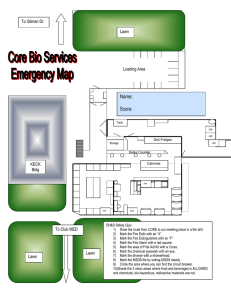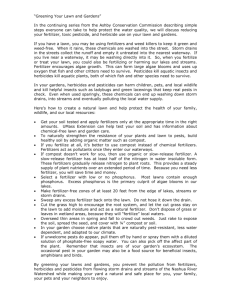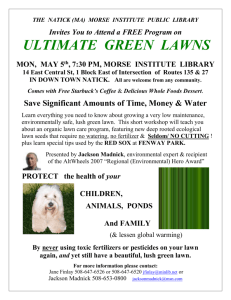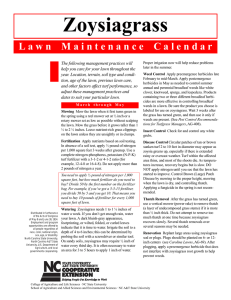Centipedegrass L a w n M a i... These suggested management practices
advertisement
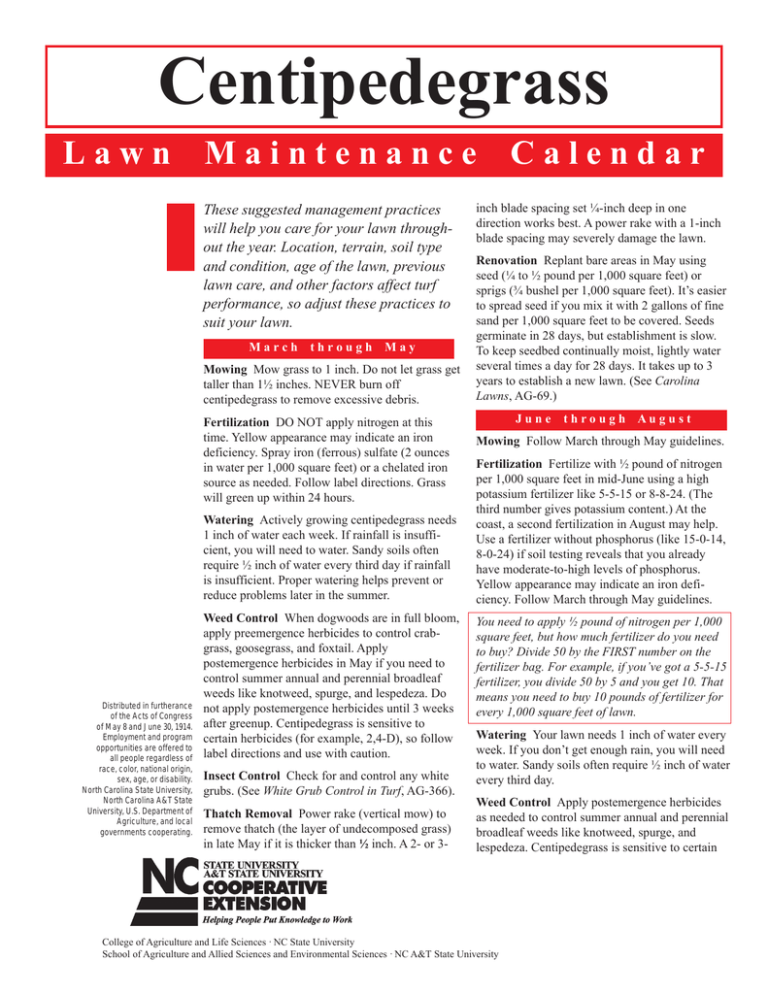
Centipedegrass Lawn Maintenance Calendar These suggested management practices will help you care for your lawn throughout the year. Location, terrain, soil type and condition, age of the lawn, previous lawn care, and other factors affect turf performance, so adjust these practices to suit your lawn. March through May Mowing Mow grass to 1 inch. Do not let grass get taller than 1½ inches. NEVER burn off centipedegrass to remove excessive debris. Fertilization DO NOT apply nitrogen at this time. Yellow appearance may indicate an iron deficiency. Spray iron (ferrous) sulfate (2 ounces in water per 1,000 square feet) or a chelated iron source as needed. Follow label directions. Grass will green up within 24 hours. Watering Actively growing centipedegrass needs 1 inch of water each week. If rainfall is insufficient, you will need to water. Sandy soils often require ½ inch of water every third day if rainfall is insufficient. Proper watering helps prevent or reduce problems later in the summer. Distributed in furtherance of the Acts of Congress of May 8 and June 30, 1914. Employment and program opportunities are offered to all people regardless of race, color, national origin, sex, age, or disability. North Carolina State University, North Carolina A&T State University, U.S. Department of Agriculture, and local governments cooperating. Weed Control When dogwoods are in full bloom, apply preemergence herbicides to control crabgrass, goosegrass, and foxtail. Apply postemergence herbicides in May if you need to control summer annual and perennial broadleaf weeds like knotweed, spurge, and lespedeza. Do not apply postemergence herbicides until 3 weeks after greenup. Centipedegrass is sensitive to certain herbicides (for example, 2,4-D), so follow label directions and use with caution. Insect Control Check for and control any white grubs. (See White Grub Control in Turf, AG-366). Thatch Removal Power rake (vertical mow) to remove thatch (the layer of undecomposed grass) in late May if it is thicker than ½ inch. A 2- or 3- inch blade spacing set ¼-inch deep in one direction works best. A power rake with a 1-inch blade spacing may severely damage the lawn. Renovation Replant bare areas in May using seed (¼ to ½ pound per 1,000 square feet) or sprigs (¾ bushel per 1,000 square feet). It’s easier to spread seed if you mix it with 2 gallons of fine sand per 1,000 square feet to be covered. Seeds germinate in 28 days, but establishment is slow. To keep seedbed continually moist, lightly water several times a day for 28 days. It takes up to 3 years to establish a new lawn. (See Carolina Lawns, AG-69.) June through August Mowing Follow March through May guidelines. Fertilization Fertilize with ½ pound of nitrogen per 1,000 square feet in mid-June using a high potassium fertilizer like 5-5-15 or 8-8-24. (The third number gives potassium content.) At the coast, a second fertilization in August may help. Use a fertilizer without phosphorus (like 15-0-14, 8-0-24) if soil testing reveals that you already have moderate-to-high levels of phosphorus. Yellow appearance may indicate an iron deficiency. Follow March through May guidelines. You need to apply ½ pound of nitrogen per 1,000 square feet, but how much fertilizer do you need to buy? Divide 50 by the FIRST number on the fertilizer bag. For example, if you’ve got a 5-5-15 fertilizer, you divide 50 by 5 and you get 10. That means you need to buy 10 pounds of fertilizer for every 1,000 square feet of lawn. Watering Your lawn needs 1 inch of water every week. If you don’t get enough rain, you will need to water. Sandy soils often require ½ inch of water every third day. Weed Control Apply postemergence herbicides as needed to control summer annual and perennial broadleaf weeds like knotweed, spurge, and lespedeza. Centipedegrass is sensitive to certain College of Agriculture and Life Sciences · NC State University School of Agriculture and Allied Sciences and Environmental Sciences · NC A&T State University herbicides (like 2,4-D, MSMA), so be careful and follow label directions. Do not apply herbicides unless grass and weeds are actively growing and lawn is not suffering from drought stress. Insect Control Check for and control any white grubs. (See White Grub Control in Turf, AG-366.) If you suspect nematode damage, contact your county Extension Center about soil testing. September through Weed Control Apply broadleaf herbicides as necessary to control chickweed and henbit. Centipedegrass is sensitive to certain herbicides (like 2,4-D), so be careful and follow label directions exactly. Selected herbicides (like atrazine or simazine) can be applied in November or December to control annual bluegrass and several winter annual broadleaf weeds. More About November Mowing Continue mowing your lawn to 1 inch before it gets taller than 1½ inches. Raise the mowing height to 1½ inches several weeks before the first expected hard frost, normally late September in the piedmont. Fertilization Fertilize with 1 pound of potassium (K2O) per 1,000 square feet 4 to 6 weeks before the first expected frost using 1.6 pounds of muriate of potash (0-0-60) or 2 pounds of potassium sulfate (0-0-50). DO NOT lime unless a soil test recommends lime. You need to apply 1 pound of potash per 1,000 square feet, but how much fertilizer do you need to buy? Divide 100 by the THIRD number on the fertilizer bag. For example, if you’ve got a 6-6-12 fertilizer, divide 100 by 6 and you get 8.3. That means you need to buy 8.3 pounds of fertilizer for every 1,000 square feet of lawn. Insect Control Follow March through May guidelines. Watering Follow March through May guidelines until the lawn browns (becomes dormant). Then water to keep soil from becoming powder dry. December through February Centipedegrass Centipedegrass is a slow-growing, apple-green, coarse-leafed turfgrass. It is a low-maintenance, general-purpose turf. It requires only ½ pound of nitrogen per 1,000 square feet per year, doesn’t need to be mowed frequently, and grows well in full sun to moderate shade. It does not tolerate traffic, compaction, highphosphorus soils, low-potassium soils, high pH, excessive thatch, drought, or heavy shade. Centipedegrass is susceptible to nematodes, ground pearls (an insect), and fairy ring (a disease). Nematode damage appears as weak areas invaded by weeds. If you suspect nematodes talk to your Cooperative Extension agent about submitting a soil sample for analysis. (See Problems on Centipedegrass, Plant Pathology Information Note 241.) Ground pearl damage appears as circular dead areas with only weeds growing in the center. (See Ground Pearls, NCSU Department of Entomology Insect Note 64.) Fairy rings appear as circular green or dead areas that continue to enlarge for several years. (See Diseases of Warm-Season Grasses, AG360.) Some broadleaf weed control herbicides and mismanagement can cause similar symptoms, so talk with your Cooperative Extension agent. Mowing Remove lawn debris (rocks, sticks, and leaves). NEVER burn off centipedegrass to remove excessive debris. Proper lawn management practices help you prevent and control centipedegrass problems. If centipedegrass continues to die in a certain location, you may need to choose another species. Fertilization DO NOT fertilize centipedegrass at this time. Submit a soil sample for analysis every 3 years to determine nutrient requirements. Contact your county Extension Center for details. Apply lime or sulfur ONLY if the soil test recommends it. Some maintenance programs provided by professional lawn care service companies differ from recommendations given here and are equally effective. Watering Water occasionally during dry spells. Prepared by Arthur H. Bruneau, Crop Science Extension Specialist, Turfgrass, with contributions and assistance from the following: Matthew C. Martin, Area Specialized Agent, Turfgrass Henry C. Wetzel, Extension Plant Pathology Specialist, Turfgrass Rick L. Brandenburg, Extension Entomologist Fred H. Yelverton, Extension Crop Science Specialist, Weed Management Cale A. Bigelow, Extension Associate, Turfgrass For more information, visit the N.C. State Turf-files Web site at http://www.ces.ncsu.edu/TurfFiles/ Recommendations of the use of agricultural chemicals and products are included in this publication as a convenience to the reader. The use of brand names and any mention of or listing of commercial productions does not imply endorsement by the North Carolina Cooperative Extension Service nor discrimination against products or services not mentioned. Individuals who use agricultural chemicals are responsible for ensuring that the intended use complies with current regulations and conforms to the product label. Be sure to obtain current information about regulations and examine a current label before applying any chemical. For assistance, contact your county Cooperative Extension agent. Published by North Carolina Cooperative Extension Service 12/00—3M—JMG E01-38901 (Revised) AG-381
